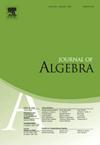Relative modality of elements in generalized Takiff Lie algebras
IF 0.8
2区 数学
Q2 MATHEMATICS
引用次数: 0
Abstract
Given a natural number m and a finite dimensional complex Lie algebra , the generalized Takiff Lie algebra of is the Lie algebra . For , we define the -modality of an adjoint orbit in to be the minimum codimension of an adjoint orbit in the pullback of in .
In this paper, we study these invariants in generalized Takiff Lie algebras associated to a quadratic Lie algebra . We show that these invariants satisfy some concavity and hereditary properties from which we deduce that is a lower bound, where is the index of . We prove that this lower bound is in fact an equality for a dense set of orbits, and that if is reductive, it is always an equality when (and also some special orbits). We conjecture that equality holds for all m, n when is reductive.
广义Takiff Lie代数中元素的相对模态
给定一个自然数m和一个有限维复李代数g, g的第m个广义Takiff李代数是李代数gm:=g⊗C[T]/Tm+1。当n≥m时,我们定义gm中伴随轨道Ωm的(m,n)-模态为gn中Ωm回拉时伴随轨道的最小余维。在本文中,我们研究这些不变量的广义Takiff单李代数相关二次李代数g。我们表明,这些不变量满足一些凹度和遗传特性,我们推断出(n−m)χ(g)是一个下界,在χ(g)的指数g。我们证明这个下界是事实上的平等密集的轨道,如果g是还原,这总是一个平等m = 0时(以及一些特殊的轨道)。我们推测当g是约化的时,等式对所有m, n都成立。
本文章由计算机程序翻译,如有差异,请以英文原文为准。
求助全文
约1分钟内获得全文
求助全文
来源期刊

Journal of Algebra
数学-数学
CiteScore
1.50
自引率
22.20%
发文量
414
审稿时长
2-4 weeks
期刊介绍:
The Journal of Algebra is a leading international journal and publishes papers that demonstrate high quality research results in algebra and related computational aspects. Only the very best and most interesting papers are to be considered for publication in the journal. With this in mind, it is important that the contribution offer a substantial result that will have a lasting effect upon the field. The journal also seeks work that presents innovative techniques that offer promising results for future research.
 求助内容:
求助内容: 应助结果提醒方式:
应助结果提醒方式:


